COIT20261: Network Routing & Switching
VerifiedAdded on 2021/06/14
|8
|2354
|54
AI Summary
Contribute Materials
Your contribution can guide someone’s learning journey. Share your
documents today.
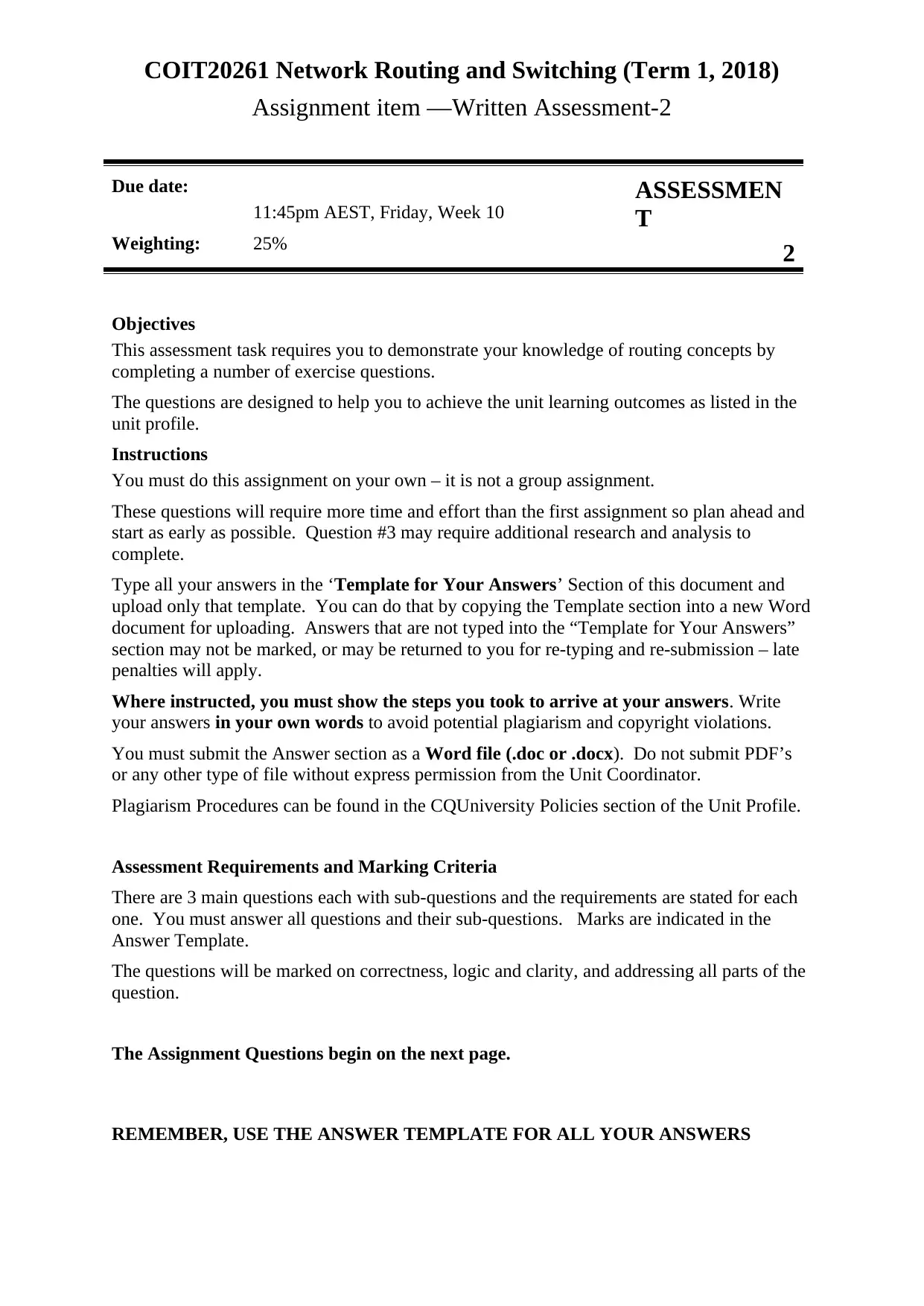
COIT20261 Network Routing and Switching (Term 1, 2018)
Assignment item —Written Assessment-2
Due date:
11:45pm AEST, Friday, Week 10
ASSESSMEN
T
Weighting: 25% 2
Objectives
This assessment task requires you to demonstrate your knowledge of routing concepts by
completing a number of exercise questions.
The questions are designed to help you to achieve the unit learning outcomes as listed in the
unit profile.
Instructions
You must do this assignment on your own – it is not a group assignment.
These questions will require more time and effort than the first assignment so plan ahead and
start as early as possible. Question #3 may require additional research and analysis to
complete.
Type all your answers in the ‘Template for Your Answers’ Section of this document and
upload only that template. You can do that by copying the Template section into a new Word
document for uploading. Answers that are not typed into the “Template for Your Answers”
section may not be marked, or may be returned to you for re-typing and re-submission – late
penalties will apply.
Where instructed, you must show the steps you took to arrive at your answers. Write
your answers in your own words to avoid potential plagiarism and copyright violations.
You must submit the Answer section as a Word file (.doc or .docx). Do not submit PDF’s
or any other type of file without express permission from the Unit Coordinator.
Plagiarism Procedures can be found in the CQUniversity Policies section of the Unit Profile.
Assessment Requirements and Marking Criteria
There are 3 main questions each with sub-questions and the requirements are stated for each
one. You must answer all questions and their sub-questions. Marks are indicated in the
Answer Template.
The questions will be marked on correctness, logic and clarity, and addressing all parts of the
question.
The Assignment Questions begin on the next page.
REMEMBER, USE THE ANSWER TEMPLATE FOR ALL YOUR ANSWERS
Assignment item —Written Assessment-2
Due date:
11:45pm AEST, Friday, Week 10
ASSESSMEN
T
Weighting: 25% 2
Objectives
This assessment task requires you to demonstrate your knowledge of routing concepts by
completing a number of exercise questions.
The questions are designed to help you to achieve the unit learning outcomes as listed in the
unit profile.
Instructions
You must do this assignment on your own – it is not a group assignment.
These questions will require more time and effort than the first assignment so plan ahead and
start as early as possible. Question #3 may require additional research and analysis to
complete.
Type all your answers in the ‘Template for Your Answers’ Section of this document and
upload only that template. You can do that by copying the Template section into a new Word
document for uploading. Answers that are not typed into the “Template for Your Answers”
section may not be marked, or may be returned to you for re-typing and re-submission – late
penalties will apply.
Where instructed, you must show the steps you took to arrive at your answers. Write
your answers in your own words to avoid potential plagiarism and copyright violations.
You must submit the Answer section as a Word file (.doc or .docx). Do not submit PDF’s
or any other type of file without express permission from the Unit Coordinator.
Plagiarism Procedures can be found in the CQUniversity Policies section of the Unit Profile.
Assessment Requirements and Marking Criteria
There are 3 main questions each with sub-questions and the requirements are stated for each
one. You must answer all questions and their sub-questions. Marks are indicated in the
Answer Template.
The questions will be marked on correctness, logic and clarity, and addressing all parts of the
question.
The Assignment Questions begin on the next page.
REMEMBER, USE THE ANSWER TEMPLATE FOR ALL YOUR ANSWERS
Secure Best Marks with AI Grader
Need help grading? Try our AI Grader for instant feedback on your assignments.
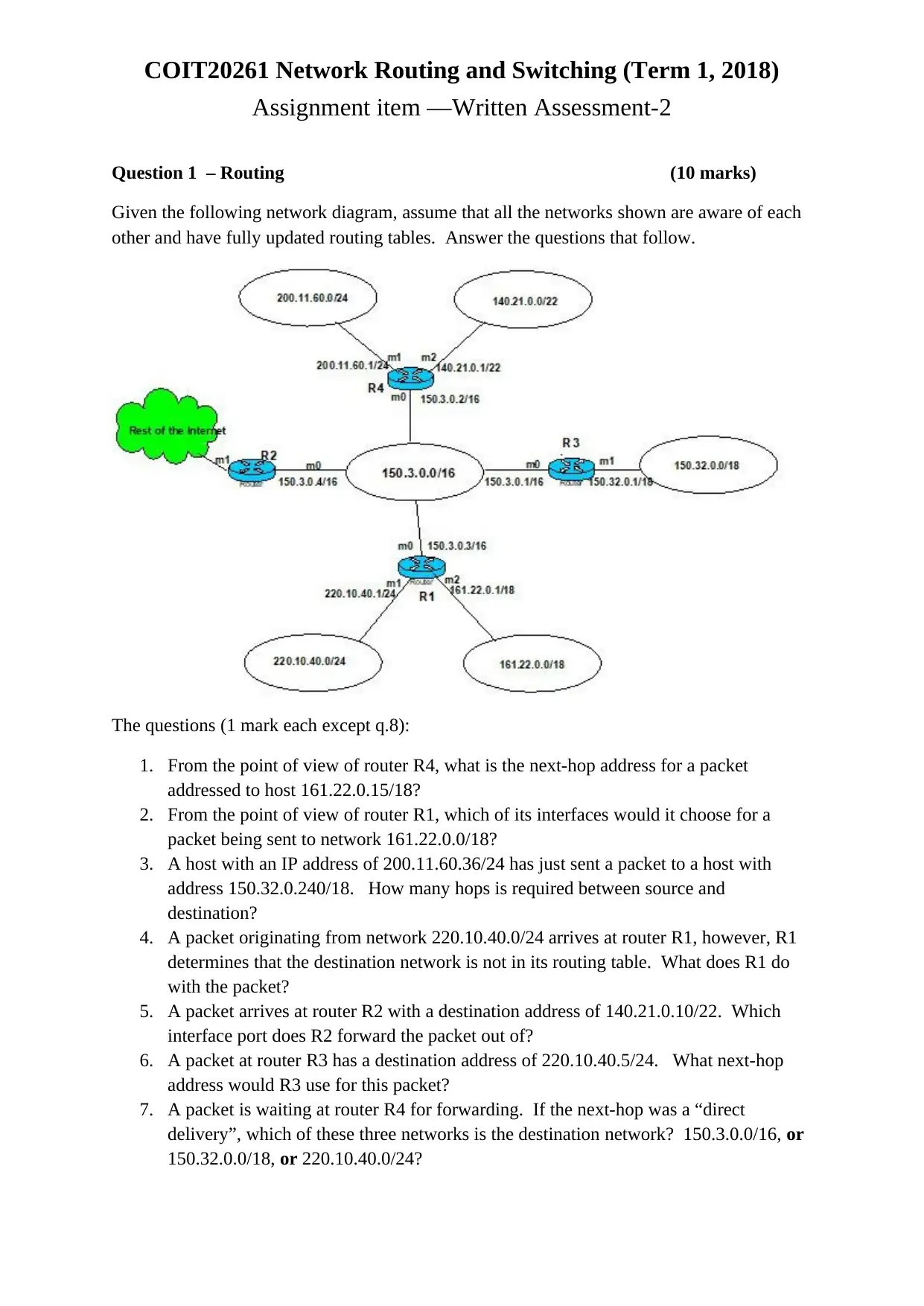
COIT20261 Network Routing and Switching (Term 1, 2018)
Assignment item —Written Assessment-2
Question 1 – Routing (10 marks)
Given the following network diagram, assume that all the networks shown are aware of each
other and have fully updated routing tables. Answer the questions that follow.
The questions (1 mark each except q.8):
1. From the point of view of router R4, what is the next-hop address for a packet
addressed to host 161.22.0.15/18?
2. From the point of view of router R1, which of its interfaces would it choose for a
packet being sent to network 161.22.0.0/18?
3. A host with an IP address of 200.11.60.36/24 has just sent a packet to a host with
address 150.32.0.240/18. How many hops is required between source and
destination?
4. A packet originating from network 220.10.40.0/24 arrives at router R1, however, R1
determines that the destination network is not in its routing table. What does R1 do
with the packet?
5. A packet arrives at router R2 with a destination address of 140.21.0.10/22. Which
interface port does R2 forward the packet out of?
6. A packet at router R3 has a destination address of 220.10.40.5/24. What next-hop
address would R3 use for this packet?
7. A packet is waiting at router R4 for forwarding. If the next-hop was a “direct
delivery”, which of these three networks is the destination network? 150.3.0.0/16, or
150.32.0.0/18, or 220.10.40.0/24?
Assignment item —Written Assessment-2
Question 1 – Routing (10 marks)
Given the following network diagram, assume that all the networks shown are aware of each
other and have fully updated routing tables. Answer the questions that follow.
The questions (1 mark each except q.8):
1. From the point of view of router R4, what is the next-hop address for a packet
addressed to host 161.22.0.15/18?
2. From the point of view of router R1, which of its interfaces would it choose for a
packet being sent to network 161.22.0.0/18?
3. A host with an IP address of 200.11.60.36/24 has just sent a packet to a host with
address 150.32.0.240/18. How many hops is required between source and
destination?
4. A packet originating from network 220.10.40.0/24 arrives at router R1, however, R1
determines that the destination network is not in its routing table. What does R1 do
with the packet?
5. A packet arrives at router R2 with a destination address of 140.21.0.10/22. Which
interface port does R2 forward the packet out of?
6. A packet at router R3 has a destination address of 220.10.40.5/24. What next-hop
address would R3 use for this packet?
7. A packet is waiting at router R4 for forwarding. If the next-hop was a “direct
delivery”, which of these three networks is the destination network? 150.3.0.0/16, or
150.32.0.0/18, or 220.10.40.0/24?
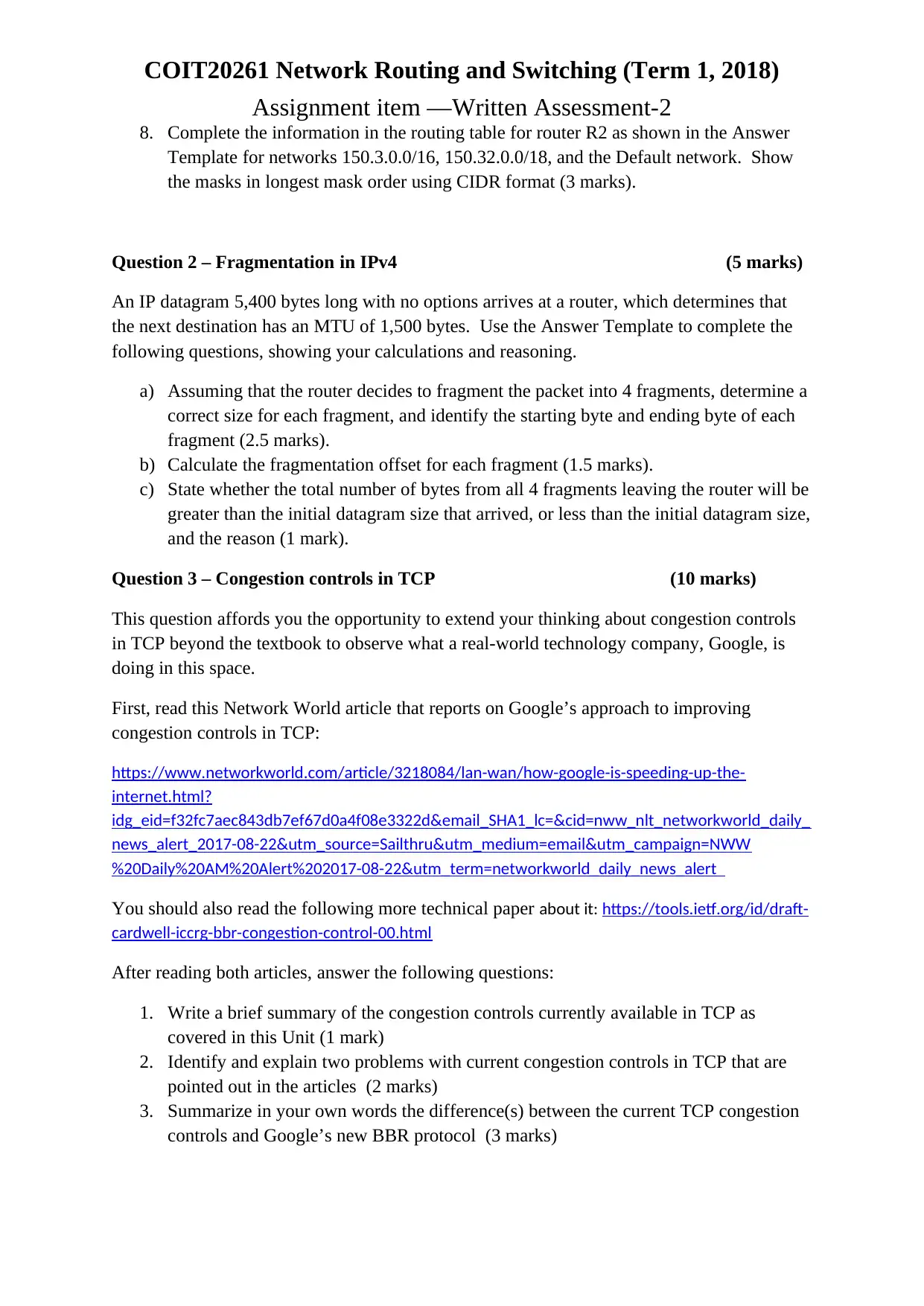
COIT20261 Network Routing and Switching (Term 1, 2018)
Assignment item —Written Assessment-2
8. Complete the information in the routing table for router R2 as shown in the Answer
Template for networks 150.3.0.0/16, 150.32.0.0/18, and the Default network. Show
the masks in longest mask order using CIDR format (3 marks).
Question 2 – Fragmentation in IPv4 (5 marks)
An IP datagram 5,400 bytes long with no options arrives at a router, which determines that
the next destination has an MTU of 1,500 bytes. Use the Answer Template to complete the
following questions, showing your calculations and reasoning.
a) Assuming that the router decides to fragment the packet into 4 fragments, determine a
correct size for each fragment, and identify the starting byte and ending byte of each
fragment (2.5 marks).
b) Calculate the fragmentation offset for each fragment (1.5 marks).
c) State whether the total number of bytes from all 4 fragments leaving the router will be
greater than the initial datagram size that arrived, or less than the initial datagram size,
and the reason (1 mark).
Question 3 – Congestion controls in TCP (10 marks)
This question affords you the opportunity to extend your thinking about congestion controls
in TCP beyond the textbook to observe what a real-world technology company, Google, is
doing in this space.
First, read this Network World article that reports on Google’s approach to improving
congestion controls in TCP:
https://www.networkworld.com/article/3218084/lan-wan/how-google-is-speeding-up-the-
internet.html?
idg_eid=f32fc7aec843db7ef67d0a4f08e3322d&email_SHA1_lc=&cid=nww_nlt_networkworld_daily_
news_alert_2017-08-22&utm_source=Sailthru&utm_medium=email&utm_campaign=NWW
%20Daily%20AM%20Alert%202017-08-22&utm_term=networkworld_daily_news_alert
You should also read the following more technical paper about it: https://tools.ietf.org/id/draft-
cardwell-iccrg-bbr-congestion-control-00.html
After reading both articles, answer the following questions:
1. Write a brief summary of the congestion controls currently available in TCP as
covered in this Unit (1 mark)
2. Identify and explain two problems with current congestion controls in TCP that are
pointed out in the articles (2 marks)
3. Summarize in your own words the difference(s) between the current TCP congestion
controls and Google’s new BBR protocol (3 marks)
Assignment item —Written Assessment-2
8. Complete the information in the routing table for router R2 as shown in the Answer
Template for networks 150.3.0.0/16, 150.32.0.0/18, and the Default network. Show
the masks in longest mask order using CIDR format (3 marks).
Question 2 – Fragmentation in IPv4 (5 marks)
An IP datagram 5,400 bytes long with no options arrives at a router, which determines that
the next destination has an MTU of 1,500 bytes. Use the Answer Template to complete the
following questions, showing your calculations and reasoning.
a) Assuming that the router decides to fragment the packet into 4 fragments, determine a
correct size for each fragment, and identify the starting byte and ending byte of each
fragment (2.5 marks).
b) Calculate the fragmentation offset for each fragment (1.5 marks).
c) State whether the total number of bytes from all 4 fragments leaving the router will be
greater than the initial datagram size that arrived, or less than the initial datagram size,
and the reason (1 mark).
Question 3 – Congestion controls in TCP (10 marks)
This question affords you the opportunity to extend your thinking about congestion controls
in TCP beyond the textbook to observe what a real-world technology company, Google, is
doing in this space.
First, read this Network World article that reports on Google’s approach to improving
congestion controls in TCP:
https://www.networkworld.com/article/3218084/lan-wan/how-google-is-speeding-up-the-
internet.html?
idg_eid=f32fc7aec843db7ef67d0a4f08e3322d&email_SHA1_lc=&cid=nww_nlt_networkworld_daily_
news_alert_2017-08-22&utm_source=Sailthru&utm_medium=email&utm_campaign=NWW
%20Daily%20AM%20Alert%202017-08-22&utm_term=networkworld_daily_news_alert
You should also read the following more technical paper about it: https://tools.ietf.org/id/draft-
cardwell-iccrg-bbr-congestion-control-00.html
After reading both articles, answer the following questions:
1. Write a brief summary of the congestion controls currently available in TCP as
covered in this Unit (1 mark)
2. Identify and explain two problems with current congestion controls in TCP that are
pointed out in the articles (2 marks)
3. Summarize in your own words the difference(s) between the current TCP congestion
controls and Google’s new BBR protocol (3 marks)
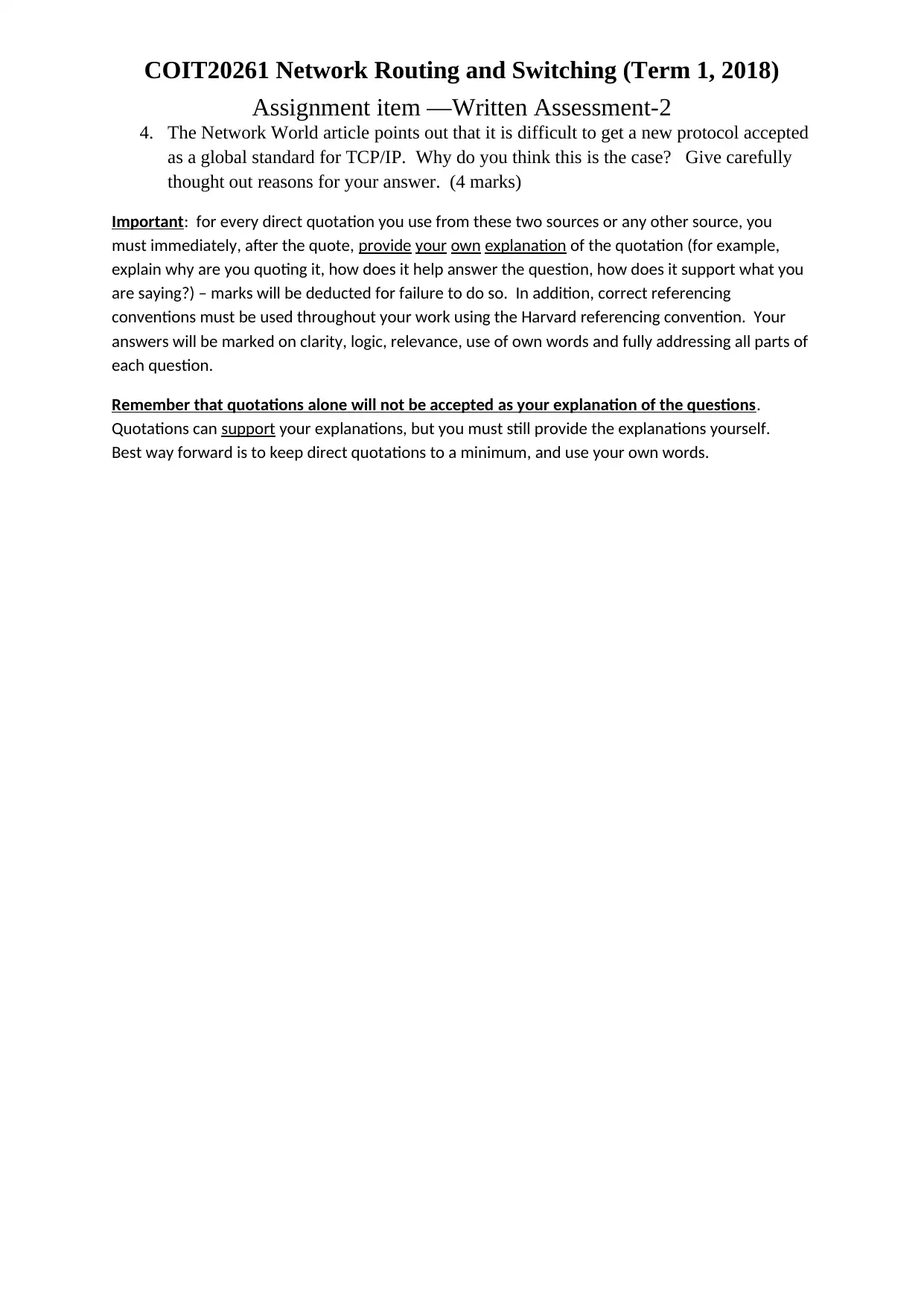
COIT20261 Network Routing and Switching (Term 1, 2018)
Assignment item —Written Assessment-2
4. The Network World article points out that it is difficult to get a new protocol accepted
as a global standard for TCP/IP. Why do you think this is the case? Give carefully
thought out reasons for your answer. (4 marks)
Important: for every direct quotation you use from these two sources or any other source, you
must immediately, after the quote, provide your own explanation of the quotation (for example,
explain why are you quoting it, how does it help answer the question, how does it support what you
are saying?) – marks will be deducted for failure to do so. In addition, correct referencing
conventions must be used throughout your work using the Harvard referencing convention. Your
answers will be marked on clarity, logic, relevance, use of own words and fully addressing all parts of
each question.
Remember that quotations alone will not be accepted as your explanation of the questions.
Quotations can support your explanations, but you must still provide the explanations yourself.
Best way forward is to keep direct quotations to a minimum, and use your own words.
Assignment item —Written Assessment-2
4. The Network World article points out that it is difficult to get a new protocol accepted
as a global standard for TCP/IP. Why do you think this is the case? Give carefully
thought out reasons for your answer. (4 marks)
Important: for every direct quotation you use from these two sources or any other source, you
must immediately, after the quote, provide your own explanation of the quotation (for example,
explain why are you quoting it, how does it help answer the question, how does it support what you
are saying?) – marks will be deducted for failure to do so. In addition, correct referencing
conventions must be used throughout your work using the Harvard referencing convention. Your
answers will be marked on clarity, logic, relevance, use of own words and fully addressing all parts of
each question.
Remember that quotations alone will not be accepted as your explanation of the questions.
Quotations can support your explanations, but you must still provide the explanations yourself.
Best way forward is to keep direct quotations to a minimum, and use your own words.
Secure Best Marks with AI Grader
Need help grading? Try our AI Grader for instant feedback on your assignments.
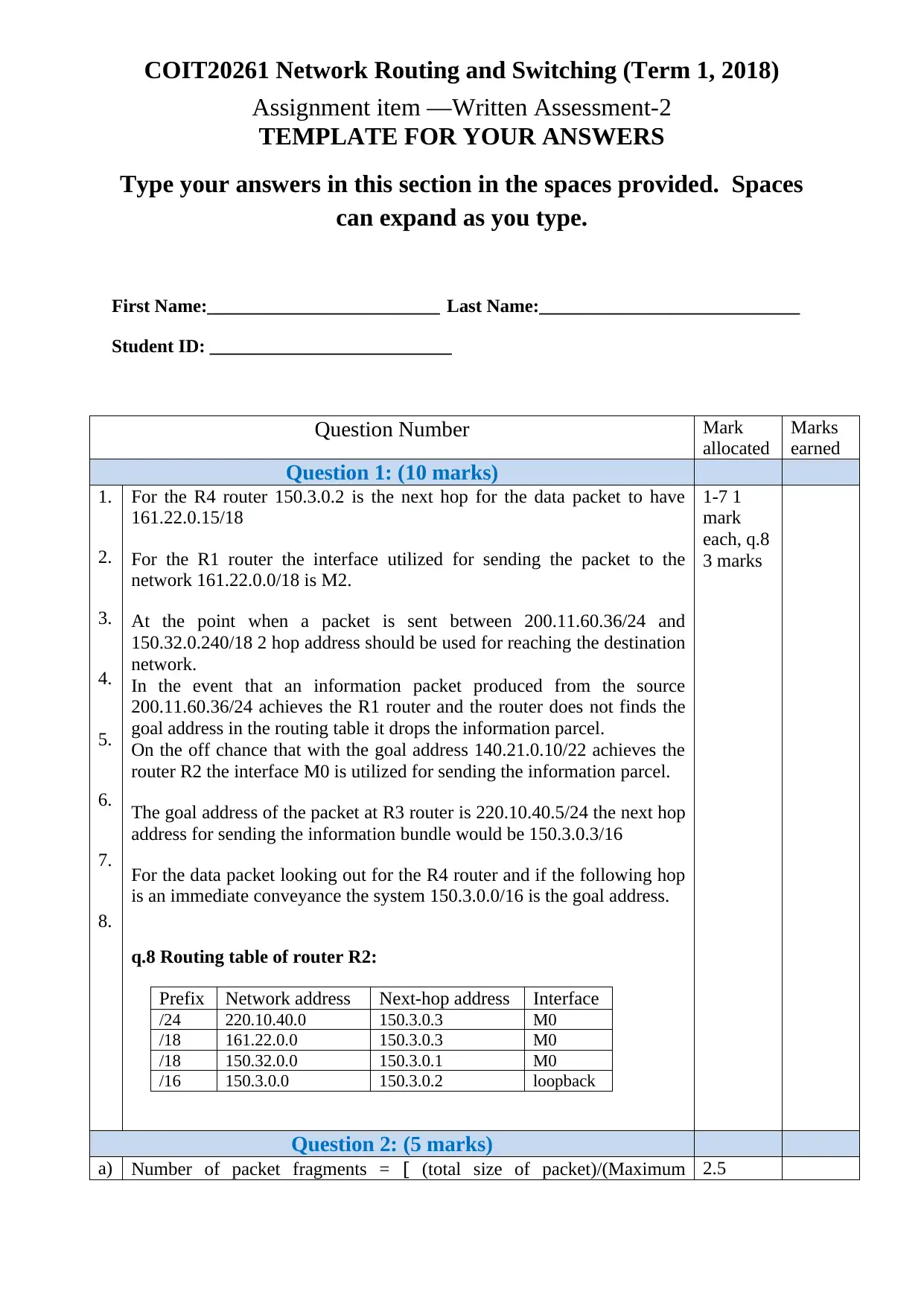
COIT20261 Network Routing and Switching (Term 1, 2018)
Assignment item —Written Assessment-2
TEMPLATE FOR YOUR ANSWERS
Type your answers in this section in the spaces provided. Spaces
can expand as you type.
First Name:_________________________ Last Name:____________________________
Student ID: __________________________
Question Number Mark
allocated
Marks
earned
Question 1: (10 marks)
1.
2.
3.
4.
5.
6.
7.
8.
For the R4 router 150.3.0.2 is the next hop for the data packet to have
161.22.0.15/18
For the R1 router the interface utilized for sending the packet to the
network 161.22.0.0/18 is M2.
At the point when a packet is sent between 200.11.60.36/24 and
150.32.0.240/18 2 hop address should be used for reaching the destination
network.
In the event that an information packet produced from the source
200.11.60.36/24 achieves the R1 router and the router does not finds the
goal address in the routing table it drops the information parcel.
On the off chance that with the goal address 140.21.0.10/22 achieves the
router R2 the interface M0 is utilized for sending the information parcel.
The goal address of the packet at R3 router is 220.10.40.5/24 the next hop
address for sending the information bundle would be 150.3.0.3/16
For the data packet looking out for the R4 router and if the following hop
is an immediate conveyance the system 150.3.0.0/16 is the goal address.
q.8 Routing table of router R2:
Prefix Network address Next-hop address Interface
/24 220.10.40.0 150.3.0.3 M0
/18 161.22.0.0 150.3.0.3 M0
/18 150.32.0.0 150.3.0.1 M0
/16 150.3.0.0 150.3.0.2 loopback
1-7 1
mark
each, q.8
3 marks
Question 2: (5 marks)
a) Number of packet fragments = [ (total size of packet)/(Maximum 2.5
Assignment item —Written Assessment-2
TEMPLATE FOR YOUR ANSWERS
Type your answers in this section in the spaces provided. Spaces
can expand as you type.
First Name:_________________________ Last Name:____________________________
Student ID: __________________________
Question Number Mark
allocated
Marks
earned
Question 1: (10 marks)
1.
2.
3.
4.
5.
6.
7.
8.
For the R4 router 150.3.0.2 is the next hop for the data packet to have
161.22.0.15/18
For the R1 router the interface utilized for sending the packet to the
network 161.22.0.0/18 is M2.
At the point when a packet is sent between 200.11.60.36/24 and
150.32.0.240/18 2 hop address should be used for reaching the destination
network.
In the event that an information packet produced from the source
200.11.60.36/24 achieves the R1 router and the router does not finds the
goal address in the routing table it drops the information parcel.
On the off chance that with the goal address 140.21.0.10/22 achieves the
router R2 the interface M0 is utilized for sending the information parcel.
The goal address of the packet at R3 router is 220.10.40.5/24 the next hop
address for sending the information bundle would be 150.3.0.3/16
For the data packet looking out for the R4 router and if the following hop
is an immediate conveyance the system 150.3.0.0/16 is the goal address.
q.8 Routing table of router R2:
Prefix Network address Next-hop address Interface
/24 220.10.40.0 150.3.0.3 M0
/18 161.22.0.0 150.3.0.3 M0
/18 150.32.0.0 150.3.0.1 M0
/16 150.3.0.0 150.3.0.2 loopback
1-7 1
mark
each, q.8
3 marks
Question 2: (5 marks)
a) Number of packet fragments = [ (total size of packet)/(Maximum 2.5
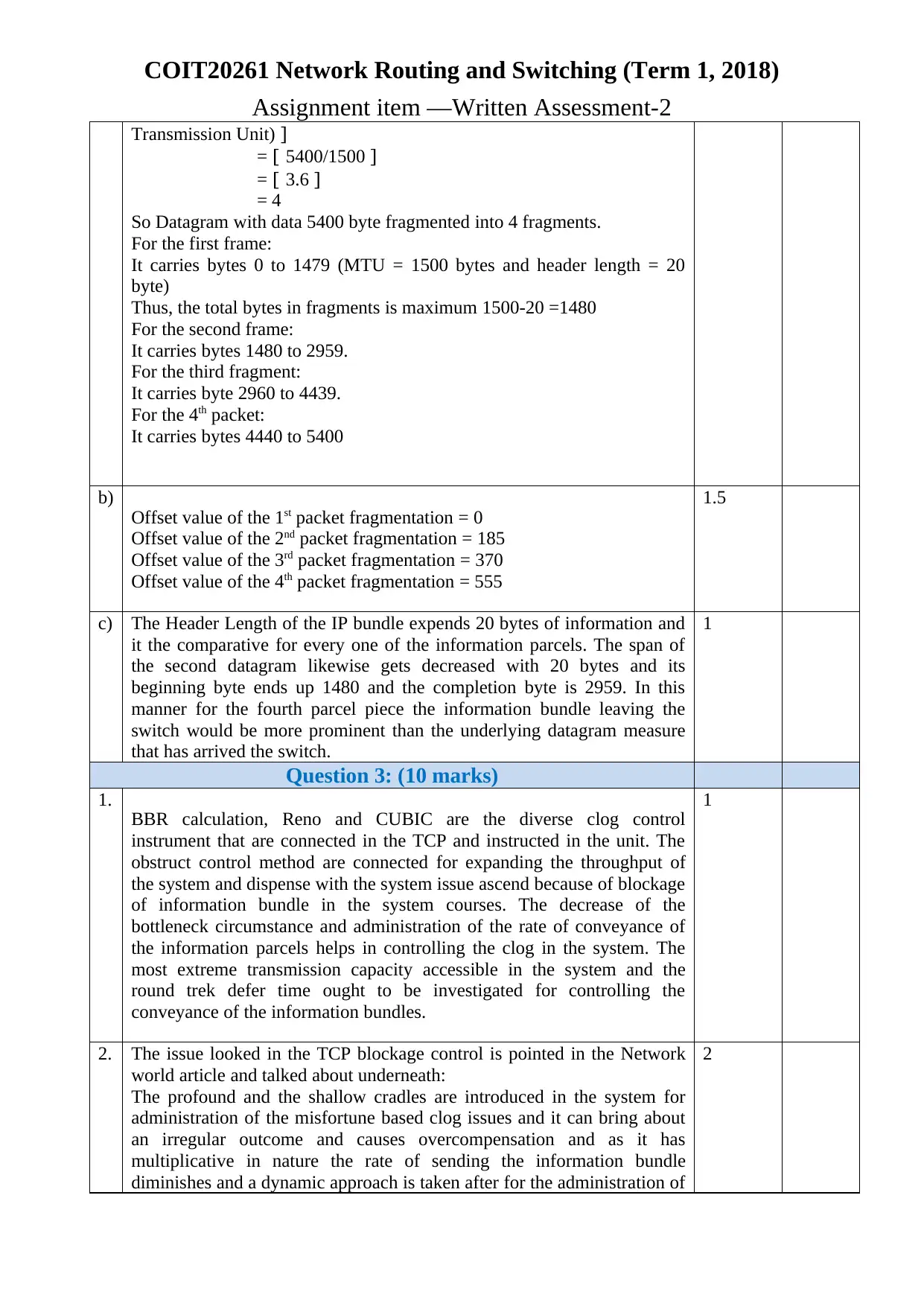
COIT20261 Network Routing and Switching (Term 1, 2018)
Assignment item —Written Assessment-2
Transmission Unit) ]
= [ 5400/1500 ]
= [ 3.6 ]
= 4
So Datagram with data 5400 byte fragmented into 4 fragments.
For the first frame:
It carries bytes 0 to 1479 (MTU = 1500 bytes and header length = 20
byte)
Thus, the total bytes in fragments is maximum 1500-20 =1480
For the second frame:
It carries bytes 1480 to 2959.
For the third fragment:
It carries byte 2960 to 4439.
For the 4th packet:
It carries bytes 4440 to 5400
b)
Offset value of the 1st packet fragmentation = 0
Offset value of the 2nd packet fragmentation = 185
Offset value of the 3rd packet fragmentation = 370
Offset value of the 4th packet fragmentation = 555
1.5
c) The Header Length of the IP bundle expends 20 bytes of information and
it the comparative for every one of the information parcels. The span of
the second datagram likewise gets decreased with 20 bytes and its
beginning byte ends up 1480 and the completion byte is 2959. In this
manner for the fourth parcel piece the information bundle leaving the
switch would be more prominent than the underlying datagram measure
that has arrived the switch.
1
Question 3: (10 marks)
1.
BBR calculation, Reno and CUBIC are the diverse clog control
instrument that are connected in the TCP and instructed in the unit. The
obstruct control method are connected for expanding the throughput of
the system and dispense with the system issue ascend because of blockage
of information bundle in the system courses. The decrease of the
bottleneck circumstance and administration of the rate of conveyance of
the information parcels helps in controlling the clog in the system. The
most extreme transmission capacity accessible in the system and the
round trek defer time ought to be investigated for controlling the
conveyance of the information bundles.
1
2. The issue looked in the TCP blockage control is pointed in the Network
world article and talked about underneath:
The profound and the shallow cradles are introduced in the system for
administration of the misfortune based clog issues and it can bring about
an irregular outcome and causes overcompensation and as it has
multiplicative in nature the rate of sending the information bundle
diminishes and a dynamic approach is taken after for the administration of
2
Assignment item —Written Assessment-2
Transmission Unit) ]
= [ 5400/1500 ]
= [ 3.6 ]
= 4
So Datagram with data 5400 byte fragmented into 4 fragments.
For the first frame:
It carries bytes 0 to 1479 (MTU = 1500 bytes and header length = 20
byte)
Thus, the total bytes in fragments is maximum 1500-20 =1480
For the second frame:
It carries bytes 1480 to 2959.
For the third fragment:
It carries byte 2960 to 4439.
For the 4th packet:
It carries bytes 4440 to 5400
b)
Offset value of the 1st packet fragmentation = 0
Offset value of the 2nd packet fragmentation = 185
Offset value of the 3rd packet fragmentation = 370
Offset value of the 4th packet fragmentation = 555
1.5
c) The Header Length of the IP bundle expends 20 bytes of information and
it the comparative for every one of the information parcels. The span of
the second datagram likewise gets decreased with 20 bytes and its
beginning byte ends up 1480 and the completion byte is 2959. In this
manner for the fourth parcel piece the information bundle leaving the
switch would be more prominent than the underlying datagram measure
that has arrived the switch.
1
Question 3: (10 marks)
1.
BBR calculation, Reno and CUBIC are the diverse clog control
instrument that are connected in the TCP and instructed in the unit. The
obstruct control method are connected for expanding the throughput of
the system and dispense with the system issue ascend because of blockage
of information bundle in the system courses. The decrease of the
bottleneck circumstance and administration of the rate of conveyance of
the information parcels helps in controlling the clog in the system. The
most extreme transmission capacity accessible in the system and the
round trek defer time ought to be investigated for controlling the
conveyance of the information bundles.
1
2. The issue looked in the TCP blockage control is pointed in the Network
world article and talked about underneath:
The profound and the shallow cradles are introduced in the system for
administration of the misfortune based clog issues and it can bring about
an irregular outcome and causes overcompensation and as it has
multiplicative in nature the rate of sending the information bundle
diminishes and a dynamic approach is taken after for the administration of
2
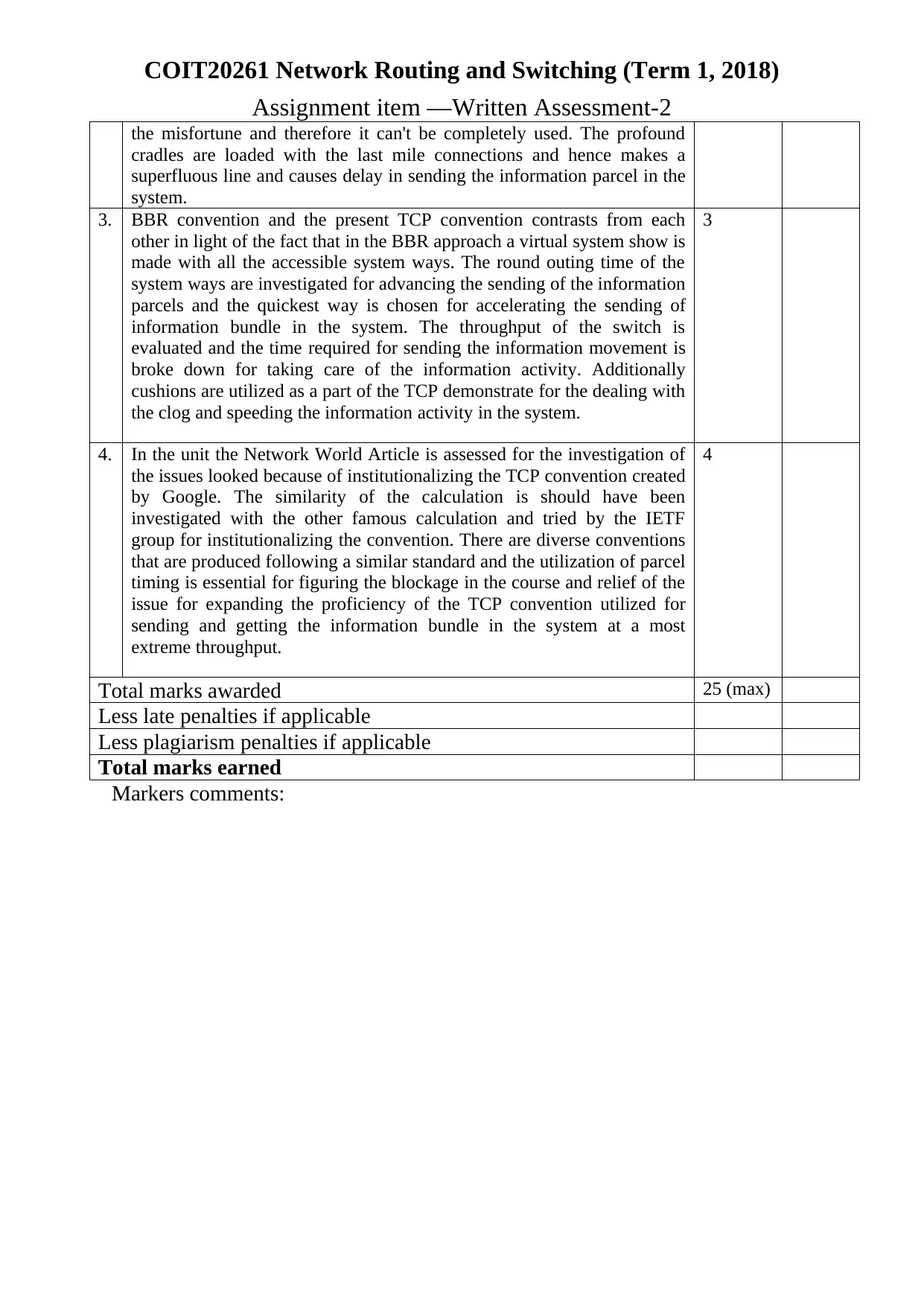
COIT20261 Network Routing and Switching (Term 1, 2018)
Assignment item —Written Assessment-2
the misfortune and therefore it can't be completely used. The profound
cradles are loaded with the last mile connections and hence makes a
superfluous line and causes delay in sending the information parcel in the
system.
3. BBR convention and the present TCP convention contrasts from each
other in light of the fact that in the BBR approach a virtual system show is
made with all the accessible system ways. The round outing time of the
system ways are investigated for advancing the sending of the information
parcels and the quickest way is chosen for accelerating the sending of
information bundle in the system. The throughput of the switch is
evaluated and the time required for sending the information movement is
broke down for taking care of the information activity. Additionally
cushions are utilized as a part of the TCP demonstrate for the dealing with
the clog and speeding the information activity in the system.
3
4. In the unit the Network World Article is assessed for the investigation of
the issues looked because of institutionalizing the TCP convention created
by Google. The similarity of the calculation is should have been
investigated with the other famous calculation and tried by the IETF
group for institutionalizing the convention. There are diverse conventions
that are produced following a similar standard and the utilization of parcel
timing is essential for figuring the blockage in the course and relief of the
issue for expanding the proficiency of the TCP convention utilized for
sending and getting the information bundle in the system at a most
extreme throughput.
4
Total marks awarded 25 (max)
Less late penalties if applicable
Less plagiarism penalties if applicable
Total marks earned
Markers comments:
Assignment item —Written Assessment-2
the misfortune and therefore it can't be completely used. The profound
cradles are loaded with the last mile connections and hence makes a
superfluous line and causes delay in sending the information parcel in the
system.
3. BBR convention and the present TCP convention contrasts from each
other in light of the fact that in the BBR approach a virtual system show is
made with all the accessible system ways. The round outing time of the
system ways are investigated for advancing the sending of the information
parcels and the quickest way is chosen for accelerating the sending of
information bundle in the system. The throughput of the switch is
evaluated and the time required for sending the information movement is
broke down for taking care of the information activity. Additionally
cushions are utilized as a part of the TCP demonstrate for the dealing with
the clog and speeding the information activity in the system.
3
4. In the unit the Network World Article is assessed for the investigation of
the issues looked because of institutionalizing the TCP convention created
by Google. The similarity of the calculation is should have been
investigated with the other famous calculation and tried by the IETF
group for institutionalizing the convention. There are diverse conventions
that are produced following a similar standard and the utilization of parcel
timing is essential for figuring the blockage in the course and relief of the
issue for expanding the proficiency of the TCP convention utilized for
sending and getting the information bundle in the system at a most
extreme throughput.
4
Total marks awarded 25 (max)
Less late penalties if applicable
Less plagiarism penalties if applicable
Total marks earned
Markers comments:
Paraphrase This Document
Need a fresh take? Get an instant paraphrase of this document with our AI Paraphraser
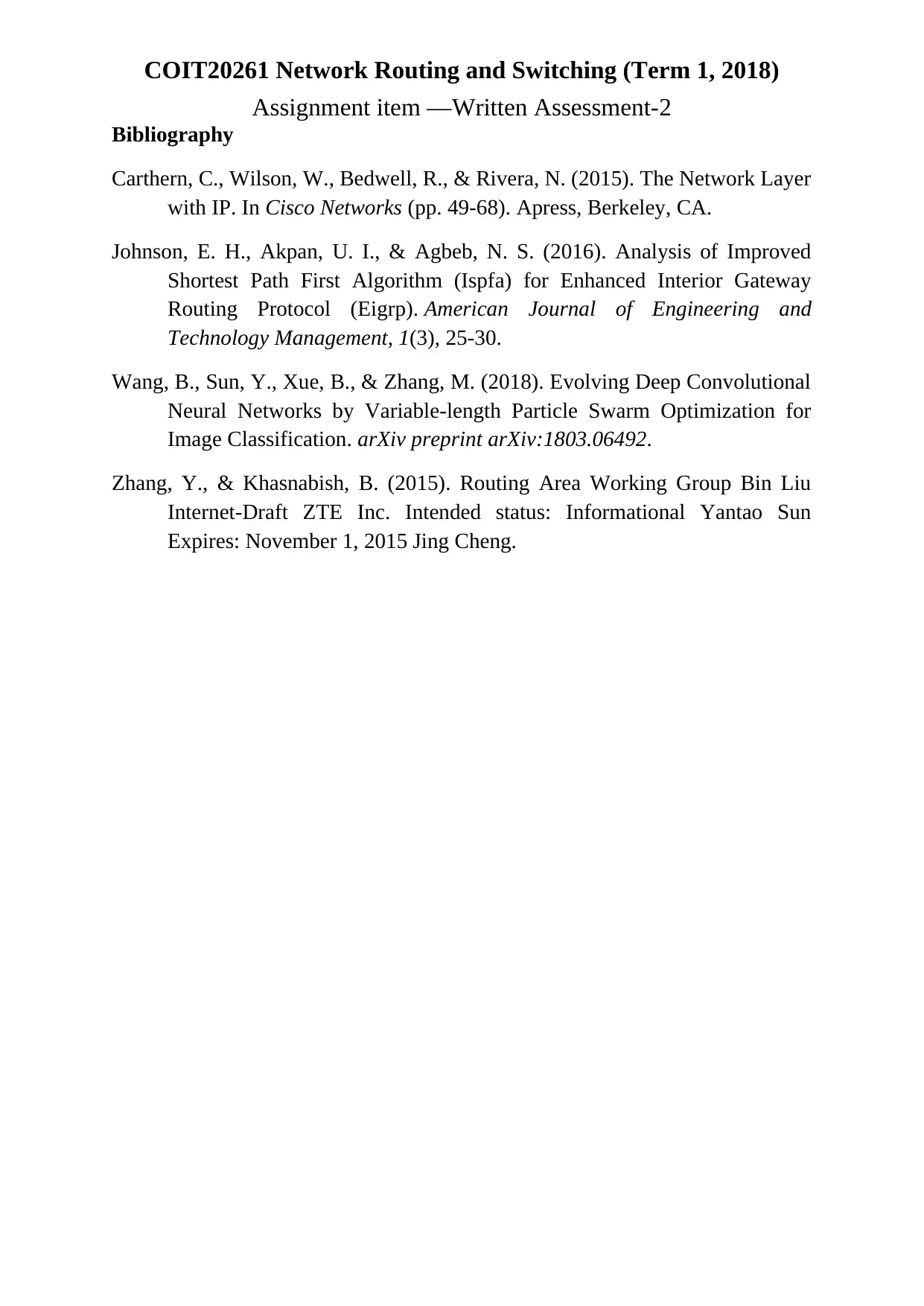
COIT20261 Network Routing and Switching (Term 1, 2018)
Assignment item —Written Assessment-2
Bibliography
Carthern, C., Wilson, W., Bedwell, R., & Rivera, N. (2015). The Network Layer
with IP. In Cisco Networks (pp. 49-68). Apress, Berkeley, CA.
Johnson, E. H., Akpan, U. I., & Agbeb, N. S. (2016). Analysis of Improved
Shortest Path First Algorithm (Ispfa) for Enhanced Interior Gateway
Routing Protocol (Eigrp). American Journal of Engineering and
Technology Management, 1(3), 25-30.
Wang, B., Sun, Y., Xue, B., & Zhang, M. (2018). Evolving Deep Convolutional
Neural Networks by Variable-length Particle Swarm Optimization for
Image Classification. arXiv preprint arXiv:1803.06492.
Zhang, Y., & Khasnabish, B. (2015). Routing Area Working Group Bin Liu
Internet-Draft ZTE Inc. Intended status: Informational Yantao Sun
Expires: November 1, 2015 Jing Cheng.
Assignment item —Written Assessment-2
Bibliography
Carthern, C., Wilson, W., Bedwell, R., & Rivera, N. (2015). The Network Layer
with IP. In Cisco Networks (pp. 49-68). Apress, Berkeley, CA.
Johnson, E. H., Akpan, U. I., & Agbeb, N. S. (2016). Analysis of Improved
Shortest Path First Algorithm (Ispfa) for Enhanced Interior Gateway
Routing Protocol (Eigrp). American Journal of Engineering and
Technology Management, 1(3), 25-30.
Wang, B., Sun, Y., Xue, B., & Zhang, M. (2018). Evolving Deep Convolutional
Neural Networks by Variable-length Particle Swarm Optimization for
Image Classification. arXiv preprint arXiv:1803.06492.
Zhang, Y., & Khasnabish, B. (2015). Routing Area Working Group Bin Liu
Internet-Draft ZTE Inc. Intended status: Informational Yantao Sun
Expires: November 1, 2015 Jing Cheng.
1 out of 8
Related Documents
Your All-in-One AI-Powered Toolkit for Academic Success.
+13062052269
info@desklib.com
Available 24*7 on WhatsApp / Email
![[object Object]](/_next/static/media/star-bottom.7253800d.svg)
Unlock your academic potential
© 2024 | Zucol Services PVT LTD | All rights reserved.





